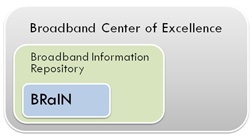Approach
At the core of BRaIN is the capability to collect data directly from businesses, organizations, and households using online questionnaires. The data is analyzed to provide key insights and shared among users – who can design specific data gathering efforts for the own needs.
Process
The process begins with initial consultation with stakeholders to identify specific information requirements or focus areas and to align on the scope of research and key analysis parameters. The research target groups (businesses, organizations, institutions, industries, households) are identified, and contact lists are sourced to invite direct participation in completing the online questionnaires. The data collected is analyzed to provide statistical results of e-solutions utilization and benefits across a range of application categories with breakouts by industry. Through the data analysis it is possible to derive a series of indices for comparative assessment of e-solutions usage by organizations on a regional basis and by industry, to identify gaps in utilization and opportunities to increase e-solutions usage. Selected analysis results can be mapped within the target region using GIS coordinates to identify clusters where e-solution utilization gaps may exist.

Essential datasets
Additional datasets need to be developed and monitored as the digital economy is becoming more pervasive throughout society. The following dataset categories focus on e-solutions adoption that deliver user value from broadband adoption:
- Utilization – How organizations are currently using or plan to use broadband in their business operations. This information informs on current state of utilization for identification of gaps and opportunities for increasing e-solutions adoption;
- Drivers – The importance of factors that motivate organizations to utilize broadband and to implement e-solutions. This information aids in focusing the value of broadband and e-solutions;
- Barriers – The importance of factors that inhibit or prevent organizations from adopting e-solutions. This information can be used to develop strategies and initiatives to overcome barriers leading to increased broadband utilization and e-solutions adoption;
- Benefits – The importance of broadband for creating positive impacts on organizations’ operations. Understanding of benefits achieved reinforces the value of broadband and e-solutions utilization;
- Impacts – The quantification of benefits in terms of employment, organization revenues, and cost efficiencies. Translating the benefits from broadband and e-solutions utilization into tangible numbers that demonstrate value and provide measurement of broadband impact;
- Profile Data – Information about organizations and their Internet connectivity for analysis by industry, employment size, and connectivity method, including time of broadband use. When combined with the e-solutions datasets this information enables focus on different market segments to increase utilization and benefits from e-solutions.
